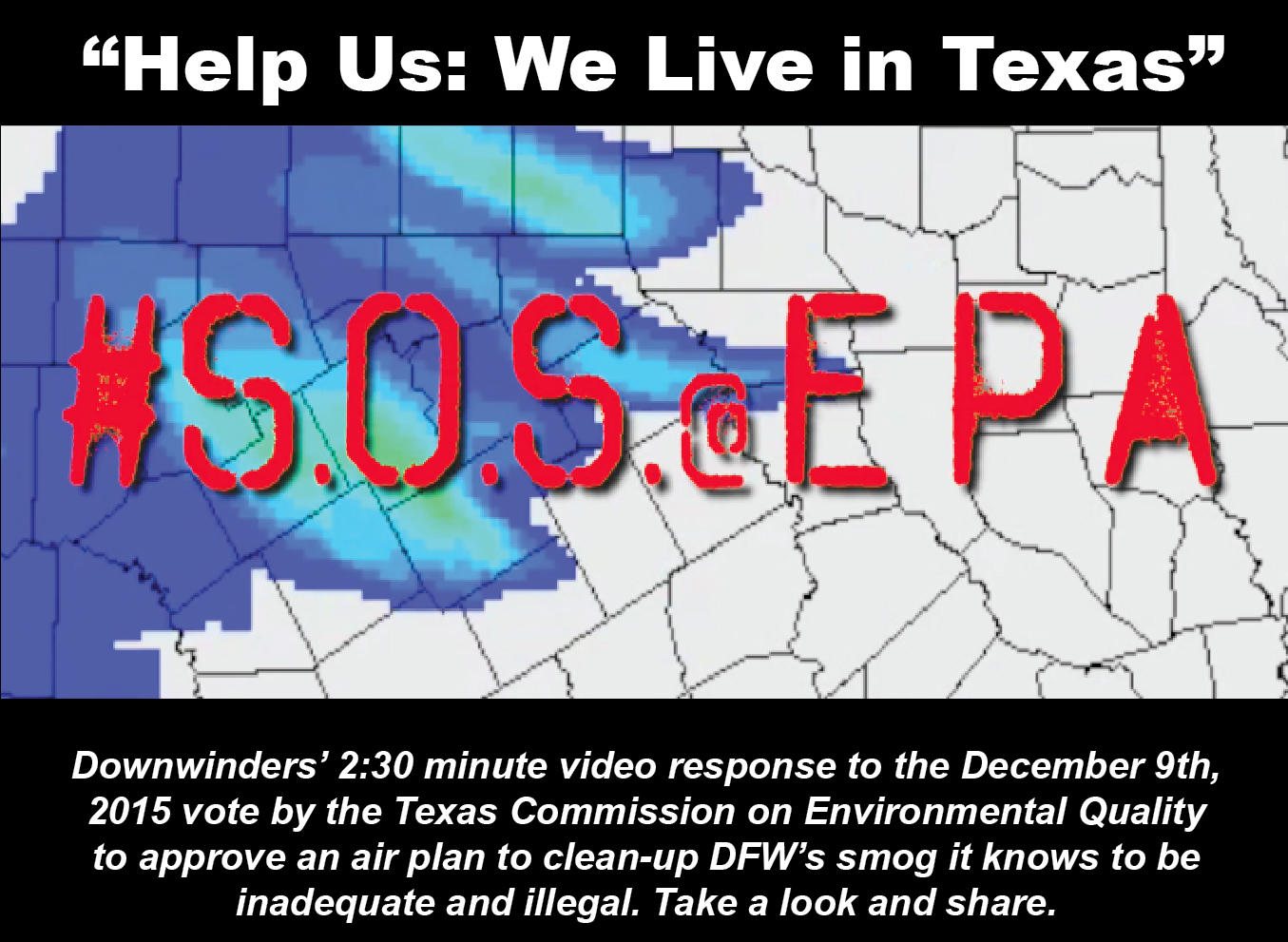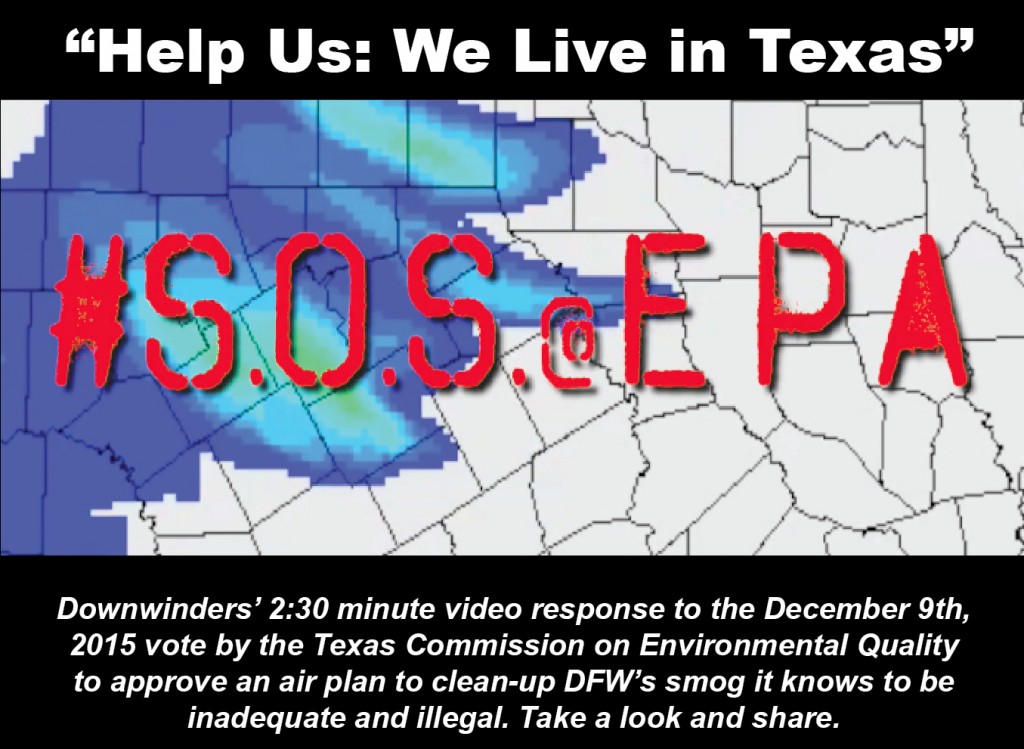DFW SIP
New Comments from EPA on DFW Air Plan: It Won’t Work
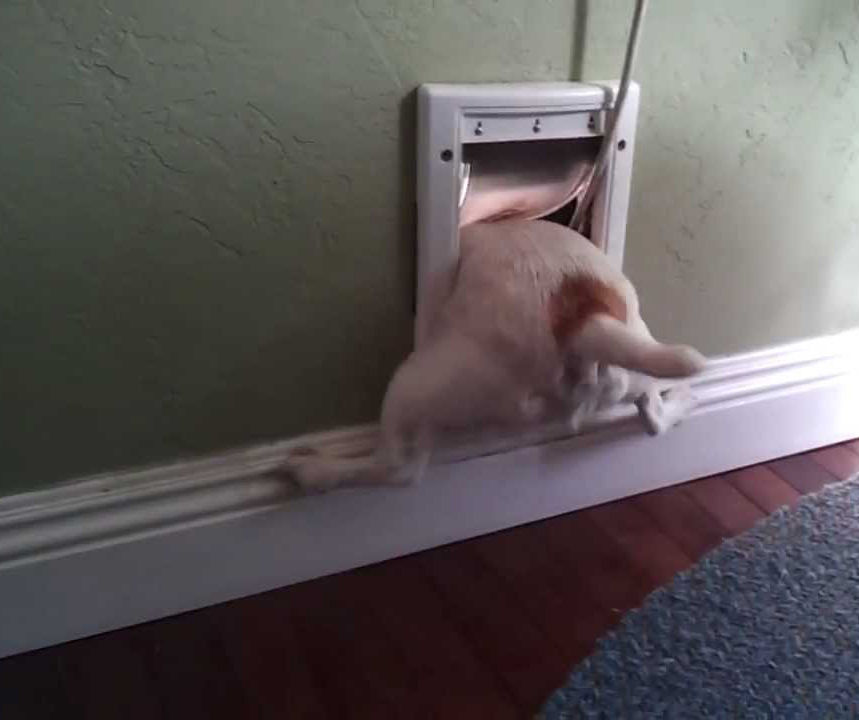 This plan won't work.
This plan won't work.
That's the simple message from the three pages of new comments Region 6 EPA staff submitted to the Texas Commission on Environmental Quality last month concerning its anti-smog plan for DFW.
That message begins with the cover letter, written by Mary Stanton, Chief of the State Implementation Plan Section for Region 6. "… additional local and regional ozone precursor emission reductions will be necessary to reach attainment by 2017."
How much in reductions? EPA estimates an additional 100-200 tons per day more in cuts of smog-forming pollution will be necessary to achieve compliance with the current 75 parts per billion ozone standard. "Without emission reductions on this scale, it is unlikely that the area will attain by the attainment date.”
To give you some idea of how large a number that is, TCEQ calculates that all gas and oil air pollution in DFW equals 78 tons per day, the Midlothian cement plants belch out over 18 tons per day, and all the power plants in the immediate DFW area, 21 tons per day. Totaled, those three sources add up to 117 tons of pollution a year.
All the cars and trucks on DFW roads are said to add up to 180 tons per day of pollution.
So the decrease in pollution EPA is saying is necessary to get down to the current ozone standard is huge.
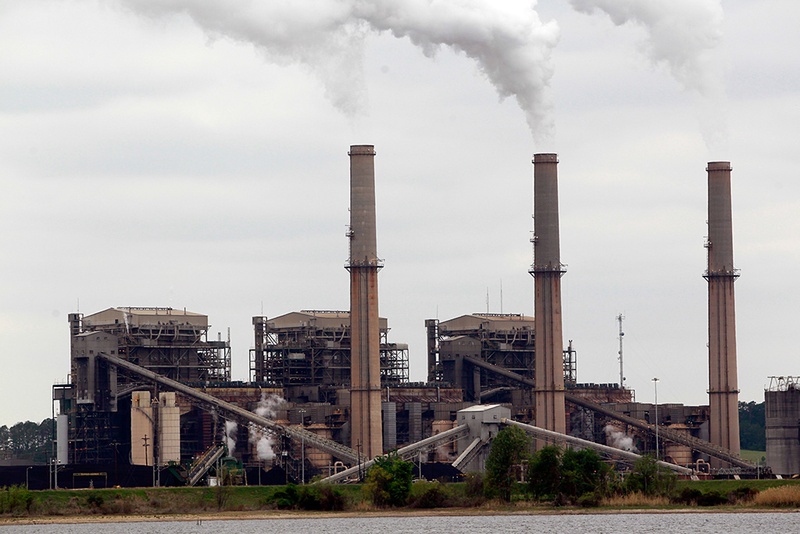
But take a look at those obsolete East Texas coal plants outside the boundaries the DFW nonattainment area. TCEQ says they account for a total of 146 tons per day. Add Selective Catalytic Reduction (SCR) which can get you up to 90% reductions in coal plant emissions, or close them down completely, add decreases from new controls on the cement kilns and oil and gas sources, and you're well on your way to amassing 200 tons a day of cuts in pollution.
Which do you think is more attractive to most DFW residents: permanently parking their cars, or putting new controls on the coal plants? Even though the coal plants harm the whole DFW airshed more than any other major source, they're not held accountable to the same regulatory requirements as sources closer to the center of the urban core, but which have less impact. Our cars must have special gasoline formulas in summer, we have to have HOV lanes, and we still go through Ozone Action Days, but the coal plants party like it's 1979. TCEQ is taking a hands-off approach to the plants and as a result the DFW region will continue to be in violation of the smog standard or huge cuts from other sources will be necessary.
TCEQ could have added new controls to the coal plants to the plan, but it chose not to. In fact, there are no new controls in the state's plan on any major sources of air pollution affecting DFW. EPA's new comments go to the heart of that choice. "Without additional emission reduction measures, we don’t see how the area will meet the standard of 75 ppb by the end of the 2017 ozone season," writes EPA staff.
EPA goes on to say TCEQ's computer modeling supporting it's do-nothing plan is "unrealistic," severely underestimating future smog levels, and delivering projections of decreases "that seem unlikely to be reached."
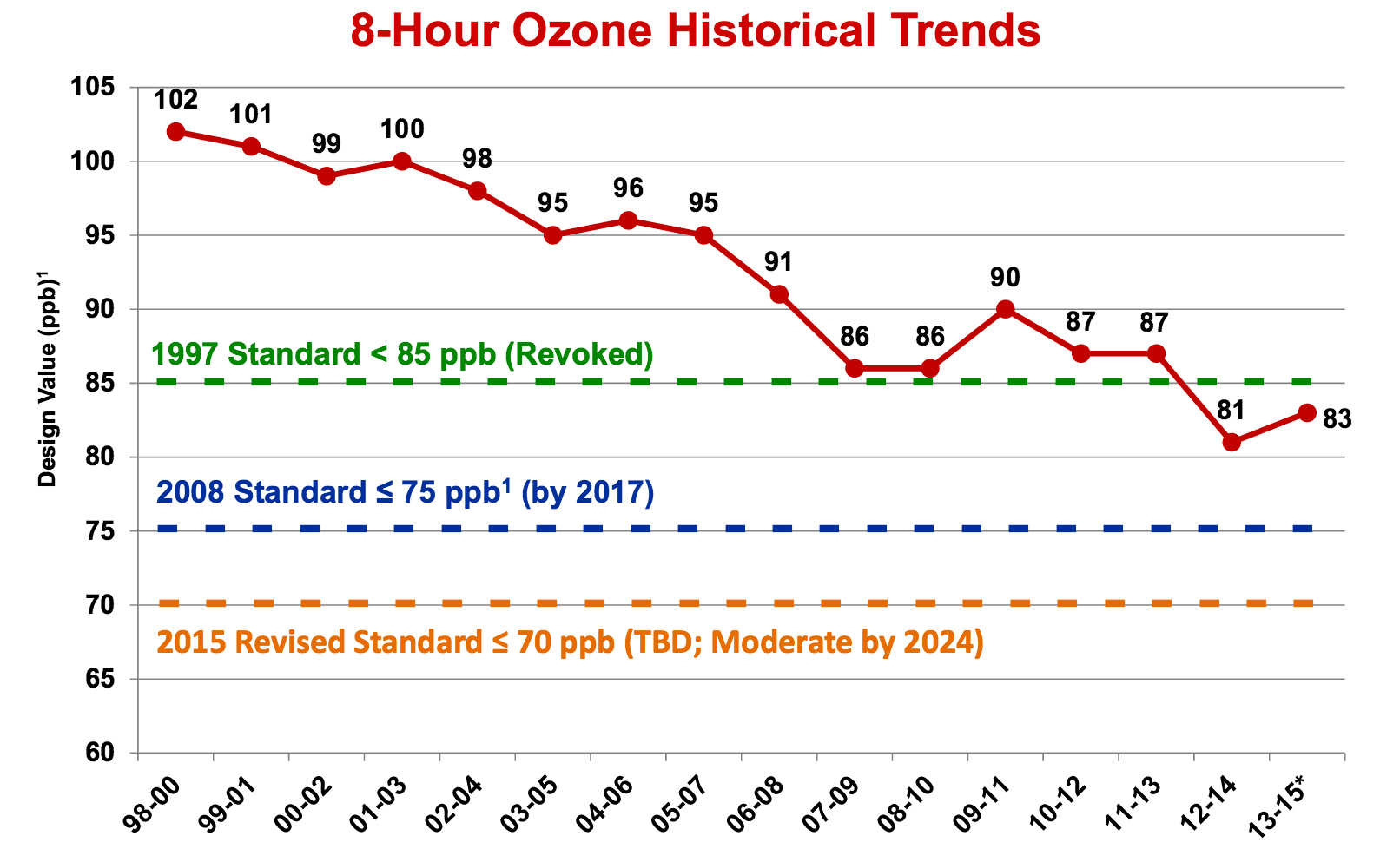 With this stance, EPA seems poised to reject this "attainment demonstration" part of the air plan as being insufficient. But it must wait to see how TCEQ responds to EPA comments about its modeling shortcomings and need for new cuts when the state officially submits its plan this July. Then, and ony then can the Agency approve or disapprove. We're going out on a limb here and predicting TCEQ won't change a thing, thus inviting EPA disapproval.
With this stance, EPA seems poised to reject this "attainment demonstration" part of the air plan as being insufficient. But it must wait to see how TCEQ responds to EPA comments about its modeling shortcomings and need for new cuts when the state officially submits its plan this July. Then, and ony then can the Agency approve or disapprove. We're going out on a limb here and predicting TCEQ won't change a thing, thus inviting EPA disapproval.
That's the pattern TCEQ has already established with its "screw you" response to the EPA's comments about the part of the plan dealing with "Reasonably Available Control Technology," or RACT, last February. This second part decides what new controls should be required of major sources of air pollution within the 10-County DFW "non-attainment" area – like the Midlothian cement plants and the thousands of oil and gas facilities checkerboarding the western half of the Metromess.
TCEQ says nothing new is required. EPA disagrees. EPA told TCEQ last year it had to do a new RACT review and lower the kiln's emission limits to account for a new generation of technology or it would have to reject the state's plan. TCEQ ignored the request, daring the EPA to disapprove. EPA seems more than willing to take them up on the offer.
And so while you're waiting for the state's computer modeling and suspect math to be rejected by EPA in July, you can probably expect to see EPA officially rejecting the RACT part of the state's plan sooner – maybe as soon as the next 60-90 days.
Despite the TCEQ going out of its way to submit an unacceptable plan to EPA, if the Agency pulls the trigger and begins a federal takeover of the DFW air plan, the Commission and the whole of Texas State Government will cry bloody murder about the usurpation of the state's authority and once again proclaim how "out of control" the EPA is on their way to filing suit.
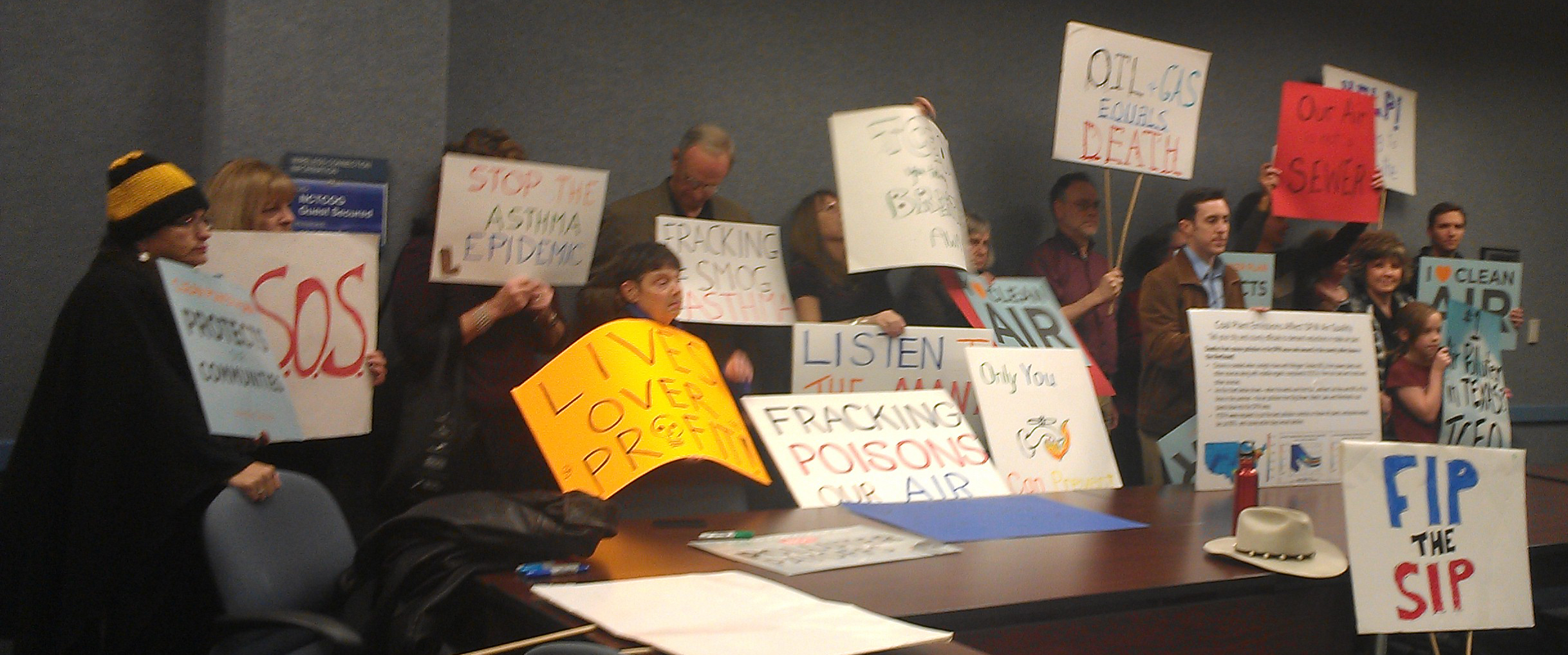 This is why the rowdy eruption of public sentiment for an EPA plan at the hearing in Arlington two weeks ago was so critical (Thank you again). It's also why we now have to be about the business of getting DFW local governments, hospitals and school districts to pass resolutions in favor of an EPA takeover. The Agency will need this kind of public support to counter all the criticism it will take from the Usual Suspects in Austin and DC. If you're interested in helping us pass one of these resolutions in your county, city, school or hospital district, please let us know at: downwindersatrisk@gmail.com
This is why the rowdy eruption of public sentiment for an EPA plan at the hearing in Arlington two weeks ago was so critical (Thank you again). It's also why we now have to be about the business of getting DFW local governments, hospitals and school districts to pass resolutions in favor of an EPA takeover. The Agency will need this kind of public support to counter all the criticism it will take from the Usual Suspects in Austin and DC. If you're interested in helping us pass one of these resolutions in your county, city, school or hospital district, please let us know at: downwindersatrisk@gmail.com
And as always, it's why you, and people you know should:
Thank You…for Kicking Serious State of Texas Butt Last Night
 Those were not your father's treehuggers that showed up in Arlington last night.
Those were not your father's treehuggers that showed up in Arlington last night.
Over 100 people, including 36 speakers over three hours, provided perhaps the angriest, and certainly the most profanity-laced evening of testimony ever heard in the two-decade history of state public hearings on DFW's dirty air. It's as if frustration over the last 20 years of State failures had finally found a cathartic, public release.
For the most part, speakers from communities across North Texas ignored the State and spoke directly to representatives of EPA, pleading for the Agency to take air quality planning out of the hands of a hostile Texas Commission on Environmental Quality.
But when many speakers did address the State's efforts, they didn't parse any words – at least any words that can be printed in a family newspaper, or this blog. For the first time anyone can recall, f-bombs were hurled at TCEQ over its failure to take North Texas bad air seriously. Dallasite Gary Stuard set the tone for the event early on by saying it was time for residents "to quit being so polite" about their systematic poisoning. His message was taken to heart by many of the speakers that followed.
Old, young, male, female, Black, White, Latino, mainstream group, neighborhood group, Elected officials, students, business owners, doctors, asthma suffers, parents of asthma suffers, people concerned about climate change, about fracking, about coal plant pollution, about cement kilns – it didn't matter. Not a single speaker spoke in favor of the State's plan of doing nothing about rising smog levels.
Seizing on the day's headlines, Lance Irwin from Mansfield was the first, but not last person to compare the official neglect over lead in Flint, Michigan's water supply to pollution in DFW's air supply. Arlington residents spoke – and in one instance, sung – movingly about fracking contamination making their neighborhoods unlivable. More than one testimony was dedicated to a friend or relative who'd died from a lung disease. Equal parts despair and anger.
By the time the final speakers finished, it felt more like a church revival. The Church of the Unredeemed State Agency. When was the last time you heard people say they had "fun" at a pro forma public hearing?
To be sure, more traditional voices and statements were in full force. Congresswoman Eddie Bernice Johnson sent a staff member urging the State to redo its plan. Dallas County Commissioner Theresa Daniel sent her aide to talk about the need to control coal plant pollution in the plan. Dallas City Councilwoman Sandy Greyson spoke for the need to grab this opportunity to make progress. Dr. Robert Haley of the Dallas County Medical Society and UT-SW did an excellent job of summarizing his recent study on the public health and economic costs of DFW smog and speaking to the Texas Medical Society resolution against the state plan. Rita Vinson, newly elected President of the Fort Worth League of Neighborhood Associations read a unanimous resolution passed by her group only the day before, calling for EPA to reject the plan. Lots of speakers recounted the long and winding road leading up to the current fact that DFW now has worse smog than Houston.
But it was the tossing aside of business meeting protocol and the pretense that the State had any interest in being there that made this a milestone event. Veterans of past hearings talked about how tired they were of repeating themselves. Newcomers couldn't understand how a State government that doesn't think smog is bad for you can write an effective anti-smog plan. Dentonites were rightfully resentful of seeing a plan that does nothing about smog from oil and gas sources being promoted by the same government that stole its municipal rights to regulate it themselves. Coarseness in language reflected rawness of feelings over yet another Texas attempt to undermine the EPA.
Although the weather was nasty, the major obstacle organizers faced yesterday was understandable skepticism about what good it would do to go to another useless TCEQ hearing. The answer was the need to provide EPA with political support to prepare for a federal takeover. That happened. Big Time. For three solid hours.
Thank you to everyone who participated in the worst public ass-kicking the TCEQ has ever received in DFW.

Now what?
EPA sent three staff members, including those in charge of reviewing and commenting on the State plan. They took notes. We'll get to see what the Agency thinks about this "new" plan within the next three weeks after the comment period closes and its written review becomes part of the public record.
After that, it should be a relatively short time before EPA decides to officially reject the part of the plan dealing with new controls in the 10-County "non-attainment area" – the part the State didn't do even after EPA asked TCEQ to, and explicitly told the Commission it would reject the plan unless it did.
It will take EPA longer, perhaps until the end of the year, to make a decision about the rest of the plan – the part that relies on computer modeling and estimates of future pollution. It's more technically oriented and there's more nuance than the up or down legal opinion with the control section.
And for citizens?
Send an email to EPA urging them to reject the State's awful air plan for DFW
Sign the CHANGE.ORG petition urging EPA to reject the State's plan
Forward our two-and-a-half minute video to people you know are concerned about air quality – or should be.
Submit written comments on this plan to the TCEQ:
Please reference: "Dallas-Fort Worth Attainment Demonstration for the 2008 Eight-Hour Ozone Nonattainment Area, Project Number 2015-014-SIP-NR"
via the interwebs:
http://www1.tceq.texas.gov/rules/ecomments
or fax
(512) 239-6188
Or by snail mail:
Kathy Singleton,
MC 206,
Air Quality Division, TCEQ
P.O. Box 13087
Austin, Texas 78711-3087
And get ready to campaign for resolutions supporting an EPA clean air plan for DFW from your local city council, county government, hospital districts, and school boards. We're all about building support for a federal takeover of our air quality planning between now and the end of the year when EPA is expected to make its final decision. We're coming to a governmental entity near you!
Lots is at stake. We can win the largest improvement in DFW air quality in a decade or wait another five years to try. Thursday night's showing makes clear many of us aren't willing to wait.
Onward Thru the Smog.
The First DFW “Clean Air” Plan Rejected by Doctors
 Public Hearing
Public Hearing
6:30 pm Thursday
January 21st
616 Six Flags Drive Arlington (near I-30 and Hwy 360 – map)
– First come, first serve to speak (no reserved time)
– 3-5 minutes speaking time
– Talking Points here if you need them
– NEW! Sierra Club Event at 6 pm out front
How bad is the new State of Texas "clean air" plan for DFW?
So bad the Texas Medical Association passed a resolution to reject it.
That's the Texas. Medical. Association.
As far as we know, this is the first time the state's premier medical association has expressed a formal opinion about any state air plan.
They oppose the State's plan because it contains no new controls on any sources of pollution contributing to North Texas' chronic smog problem. Not a one. At a time when DFW smog levels are going up.
They oppose the State's plan because it allows dirty air in North Texas to keep killing people and making them sick, costi us $650 million every year. Human and financial costs which are completely preventable.
Join the TMA in taking a public stand.
Residents of Texas who want clean air have to speak-up to counter our State officials who ridicule the idea.
Come to the hearing on Thursday evening and tell the State why you don't trust them with your health. Urge the EPA to reject Austin's plan and write its own.
What the Docs Say:
Some of the harshest critics of the State's proposed do-nothing DFW air plan aren't members of any environmental group. They're doctors.
At its 2015 convention in November, the Texas Medical Association endorsed a resolution urging the Association to:
"…reject the Texas Commission on Environmental Quality's (TCEQ's) 2015 State Implementation Plan (SIP) report and advocate for development of a new SIP report that conforms to the scientific, peer reviewed modeling methods developed by UT Southwestern and University of North Texas experts. TMA advocates for implementing reasonably available control measures at the state level capable of meeting national ozone standards, based on the UTSW and UNT validated models."
The resolution was the work of a delegation from the Dallas County Medical Society, headed up by Dr. Robert Haley, Epidemiologist at UT-Southwestern.
It was Haley who worked on a landmark study on local impacts of ozone that was released in tandem with Downwinder's own UNT computer air modeling study last fall. Those are the UTSW and UNT studies referenced in the TMA resolution.
Dr. Haley took the EPA's own software for estimating the health and economic costs of bad air, and applied it to DFW. What did he find?
Reducing smog by just 5 parts per billion in North Texas would:
1. Prevent 200 admissions to hospitals for respiratory illness every year
2. Prevent 400 ER visits to hospitals for respiratory illness every year
3. Prevent 140,000 lost school days every year
4. Prevent 100 premature deaths every year
5. Save $650 million a year in lost productivity
As it so happens, the most cost-effective path to lowering ozone levels across the region has been mapped out by the UNT study, which cloned the State's own computer model for DFW and ran the "what ifs" Austin isn't interested in asking anymore.
Applying off-the-shelf technology to East Texas coal plants, Midlothian cement kilns, and oil and gas facilities was shown by the UNT study to be the easiest ways to get smog levels down enough to comply with the current federal ozone standard. That's the "reasonably available control" part of the TMA resolution.
The State knows all this but refuses to include these controls in any DFW air plan – for the second time in 5 years.
Dr. Jim Walton, President of the Dallas County Medical Society took on that official stubbornness in a full-page editorial running in the group's newsletter:
"…once again TCEQ staff has announced that it sees no need to require new control measures on any major pollution sources, even while the Commission's own computer air modeling shows that DFW will remain above the 75 ppb standard….DFW is a chronic Clean Air Act violator, and much of it is avoidable. We can and should lead in this very practical and real issue that continues to threaten the health of our community."
And doctors are leading on this issue.
Despite the Dallas County Medical Society hosting its annual dinner on Thursday evening, Dr. Haley has said he'll join us in Arlington for the air plan hearing because of its importance. Come and thank him in person by adding your voice in urging EPA to take over the region's air plan.
Fight Back.
Don't Let Gregg Abbott Speak For You on This Important Issue.
Thursday, January 21st
6:30 pm
616 Six Flags Road in Arlington
First Floor Meeting Room
THE CASE FOR EPA TAKEOVER OF DFW AIR PLAN
Sign the CHANGE.ORG petition to EPA urging the Agency to reject the State's plan.
The Fastest Way to Get Big Cuts in Fracking Pollution? A Good DFW Smog Plan.
Public Hearing on DFW Air
Thursday, January 21st
6:30
616 Six Flags Road in Arlington
(Map)
If you're fighting fracking in your North Texas community, you have few options these days. The State of Texas is not only very not interested in hearing about fracking problems, it just passed a law that makes it illegal for your city to be too interested in hearing from you about those problems as well.
Enter another DFW anti-smog plan. In the past, these plans have been written by Austin and have tired their best to ignore the large volumes of smog-forming pollution from oil and gas sources. This new plan is no different. Left up to the State, there would be no new cuts in pollution from any major industrial source, including the gas industry.
But EPA may not leave it up to the state this time. There are already indications the EPA will reject the State's air plan for DFW as being inadequate and draft one of its own. That would be good news for local anti-fracking activists. Why? Because it could mean cutting lots and lots of different kinds Barnett Shale pollution throughout the region and help shift the costs of its harmful impacts to industry.
That's why if you're concerned about fracking, you owe to yourself to show-up at this Thursday's public hearing and tell the EPA you want them to reject the state's do-nothing air plan and instead implement a "Federal Implementation Plan" to clean up DFW's chronically smoggy air.
The Case For Cutting Oil and Gas Pollution in a DFW Anti-Smog Plan
1. The Oil and Gas Industry is a Large Source of Smog Pollution in North Texas
Look at the chart below for where and in what volumes the State believes smog-forming pollution will be coming from in 2017. The numbers are directly from the Texas Commission on Environmental Quality's DFW air plan. It's in TONS PER DAY.
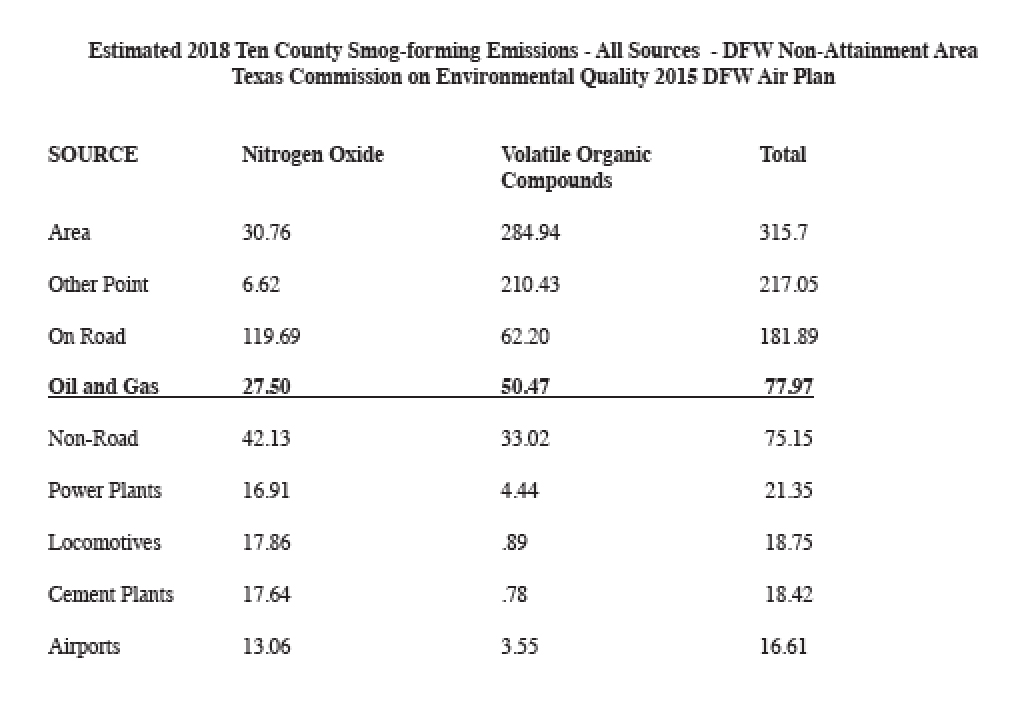
Oil and Gas pollution is the fourth largest category of smog pollution in North Texas. It's the fourth largest category for Nitrogen Oxide (NOx) pollution – the kind the State believes is most responsible for DFW smog. It's also the fourth largest source for Volatile Organic Compounds (VOCs), another kind of smog pollution that many of us believe plays a bigger role than the State thinks.
And these are the State's own numbers so you can be sure they're underestimates.
For example, a recent review of studies estimated that the Barnett Shale gas production was leaking up to twice as much climate-damaging methane as the EPA predicts. Methane doesn't escape by itself. If it's leaking, so are smog-forming VOCs that come up with the Methane.
Bottom Line: a huge new category of smog pollution has been created in DFW in just the last 8 years.
2. Oil and Gas Air Pollution is making DFW Smog Worse
Even the State admits that pollution from Barnett Shale industry sources contributes to DFW smog, the only disagreement is by how much.

Take a look at another chart – one that tracks the "average regional" smog level over the decades. Notice the downward trend that stops around 2009, where it continues to hover around 85 ppb? Can you think of anything that began happening in DFW in a big way around 2008-9 that would have stopped that downward trend?
Part of the problem is location. Historically, DFW's worst-performing air monitors, the places where the air quality always seems to be worse at the end of every "ozone action day" are located in the Northwest part of the Metromess – Keller, Grapevine, Denton, and Eagle Mountain Lake. Predominant winds are from the southeast to the northwest in summer time, pushing all of DFW's pollution toward Denton and Wise Counties.
Imagine what happens when you begin to envelope those same northwest areas into the country's largest urban gas field. In 2011, the State estimated that there was more VOC pollution coming from O&G sources in the region than from all the cars and trucks on the road in North Texas at the time.
This impact has not escaped EPA's notice. In official comments filed last February the Agency wrote that those Northwest monitors have not seen their ozone numbers come down as much as other parts of the region and suggest the sea of O&G pollution surrounding them may be the reason.
Thanks to the landmark UNT study that cloned the State's own computer air model for the DFW plan, we know exactly what kind of influence O&G pollution has on those monitors – or at least what the impacts are using the State's underestimated numbers.
If you took away all the estimated 2017 pollution from the Barnett Shale in DFW, you'd see drops in ozone of…
5.4 ppb at the Eagle Mountain Lake air monitor site
5.3 ppb in Keller
4.9 in NW Ft. Worth
3.6 ppb in Denton
These reductions in ozone would be enough to bring all of these DFW air monitor sites into compliance with the current 75 ppb standard, and allow all the sites except Denton to reach the new 70 ppb federal ozone standard more quickly than the deadline of 2025.
Conversely – you can see these numbers as the added smoggy burden the industry is imposing on DFW now. According to the State itself, O&G pollution are raising ozone levels as much as 3 to 5 ppb across large parts of the region.
3. Large Cuts in O&G Pollution = Less Smog in DFW
If oil and gas pollution is a large source of smog pollution, it makes sense that cutting that pollution would lead to less smog. Because of the UNT report, we know how much regional smog would decrease if we took some steps to stop down O&G pollution.
For example, just converting all 647 large gas compressors (point sources) in North Texas from diesel or gas to electricity – something the industry says it can do in areas with air pollution problems – would take over 16 tons of NOx pollution out of the air each and every day and lead to a drop of over 3 ppb at the Eagle Mountain Lake site and between 1 and over 2 ppb at 10 other air monitor sites. That may not sound like much, but it's enough to send most of them into compliance with the current 75 ppb standard. And that's not even accounting for the decrease in Particulate Matter pollution that would accompany such a transition. Because compressors are the industry's largest source of Nitrogen Oxides, they should be a big target for a new EPA air plan for DFW.
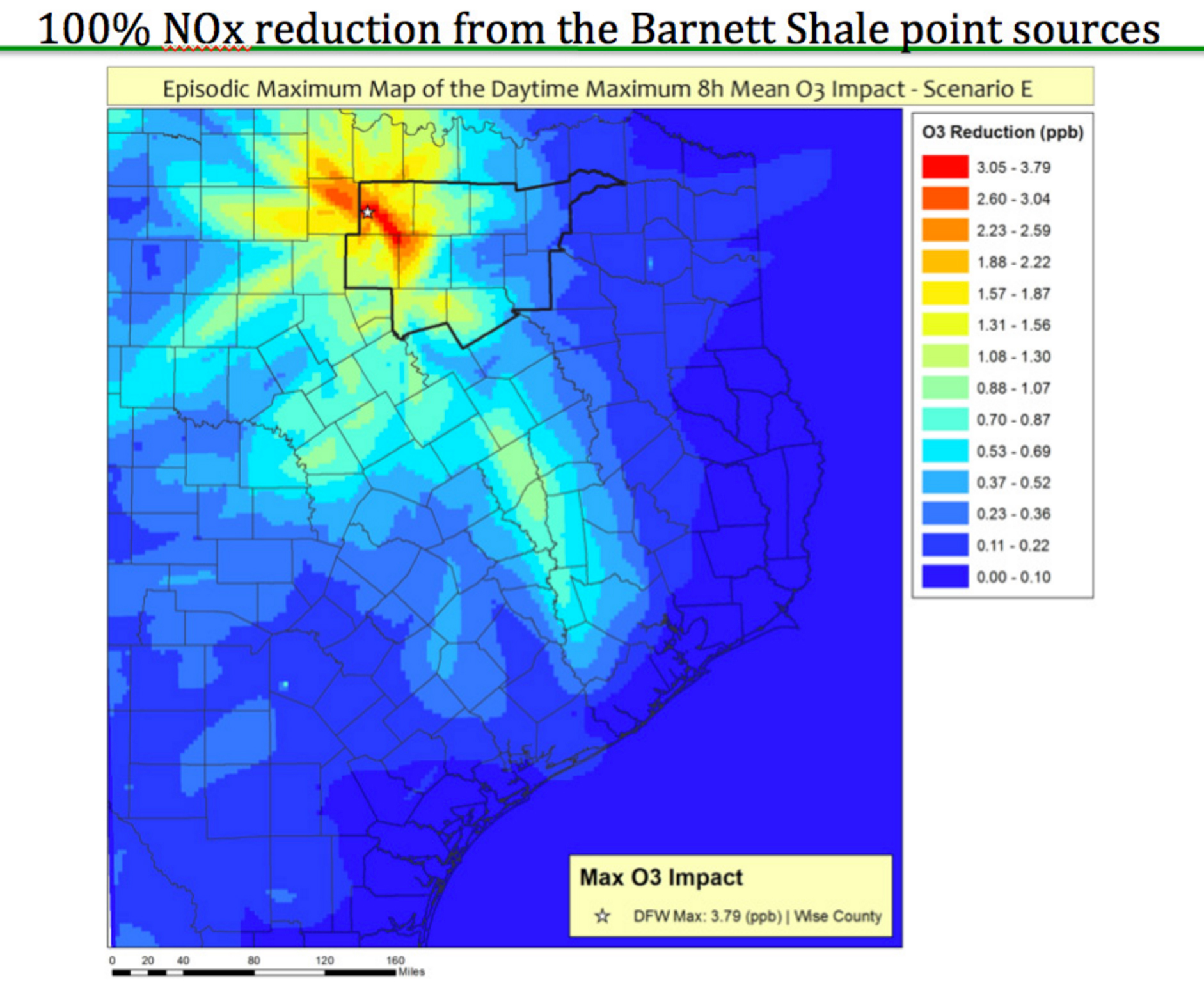 VOC pollution could also decrease under an EPA plan. Under the EPA's proposed new methane rules, there are a series of guidelines for controlling the pollutant that would also end-up cutting other smog-forming and toxic VOC pollution as a side-benefit. We're talking Benzene and all the other nasties the human eye can't see coming out of a storage tank or dehydrator.
VOC pollution could also decrease under an EPA plan. Under the EPA's proposed new methane rules, there are a series of guidelines for controlling the pollutant that would also end-up cutting other smog-forming and toxic VOC pollution as a side-benefit. We're talking Benzene and all the other nasties the human eye can't see coming out of a storage tank or dehydrator.
According to the Agency's release on the the new rules, “…reduction of VOC emissions will be very beneficial in areas where ozone levels approach or exceed the National Ambient Air Quality Standards for ozone." Areas like DFW – for the past two decades.
Under the new rules, areas like DFW that host large concentrations of gas pollution sources and are officially categorized as “non-attainment” for smog, could be the beneficiaries of new EPA-written “Control Technique Guidelines.”
According to EPA, these CTGs “provide an analysis of the available, cost-effective technologies for controlling VOC emissions from covered oil and gas sources. States would have to address these sources as part of state plans for meeting EPA’s ozone health standards.”
EPA gives states two years to include these controls in new air plans. Texas could include them now, in its current air plan, but it doesn't want to.
But if the EPA is writing our air plan instead, then these new VOC controls get put into the mix. Even a 50% cut in VOC emissions from the gas industry means 25 tons a day less air pollution from facilities over a wide area. That's worth fighting for.
If EPA rejects the state plan, it would take up to two years to implement a federal alternative. Even so, is there any other opportunity to cut as much oil and gas pollution in that amount of time? From new fedreal rules? Through local opposition? This is a chance to regionalize the fracking fight and reap large benefits.
Still steamed over HB40? Get mad AND get even.
Help us take the DFW air plan out of the State's hands, and give it to the EPA, where we can advance the cause in a way the state never dreamed of.
Thursday, January 21st
6:30
616 Six Flags Road in Arlington
THE CASE FOR EPA TAKEOVER OF DFW AIR PLAN
Sign the CHANGE.ORG petition to EPA urging the Agency to reject the State's plan.
The Fastest Way to Get Big Cuts in Climate Change Pollution? A Good DFW Anti-Smog Plan.

Public Hearing
6:30 pm Thursday
January 21st
616 Six Flags Drive Arlington
When polluters cut smog pollution, they cut a lot of other kinds of pollution as well, including climate-damaging gases like CO2 and methane.
Hundreds of thousands of tons of this kind of pollution could be eliminated in the next air plan for Dallas-Ft. Worth as a result of requiring modern controls on coal plants, cement kilns, and oil and gas sources.
Luminant's Martin Lake coal plant in East Texas is the largest global warming polluter in the country. It released 16.3 million metric tons of carbon dioxide in 2012, the equivalent of 3.5 million cars.
Recent studies show facilities in the Barnett Shale Gas Play are leaking 50% to 90% more methane than the government estimates.
We need to cut pollution here, now.
That's why if you care about climate change, you'll want to show-up next Thursday night and speak in favor of the EPA rejecting a State of Texas plan that doesn't require any new cuts in pollution from any source.
Join your earth-hugging peers in calling for a new air plan written by EPA that includes cuts in local smog pollution that can also benefit the entire planet. In as little as two years, you could make a big difference to a big problem.
Think Globally. Act Locally.
Not just a bumper sticker.
Additional Talking Points here if you need them.
SPECIFICS?
When the Ash Grove cement plant in Midlothian modernized its operations to conform with new anti-smog rules and other regulations, it cut approximately 300,000 tons of CO2 pollution – a year. That's just one cement plant.
Methane is the main ingredient in natural gas, and a highly potent greenhouse gas, with over 80 times the 20-year warming power of carbon dioxide.
EPA estimates 750,000 to one million tons of methane is released by equipment leaks every year from facilities in the Barnett Shale, but a recent peer-reviewed study estimated methane emissions in the Barnett Shale may be twice as high as EPA thinks.
There are pending EPA rules to limit methane pollution at natural gas sites that could be rolled into this DFW air plan. Even a 50% cut in leaks in North Texas would mean an annual drop of 400-500,000 tons of climate changing pollution.
A good anti-smog plan from EPA will also put more pressure on the obsolete East Texas coal plants to close.These coal plants are the biggest reasons Texas status is the #1 Greenhouse Gas polluter in the U.S.
The fastest way to cut lots of greenhouse gases in the Belly of the Beast is with a good EPA anti-smog plan for DFW.
Come speak in support of an air plan for our region that would help reduce asthma attacks here, and the melting of glaciers in Greenland.
Thursday, January 21st
6:30 pm
616 Six Flags Road in Arlington
First Floor Meeting Room
– Send EPA Administrators an email asking them to reject the State's do nothing DFW air plan and instead wrie one of their own.
– Sign the CHANGE.ORG Petition urging EPA to reject the State's air plan for DFW
It’s a Texas vs EPA Cage Match. Winner Takes All …The Air You Breathe
 JOIN OUR TAG TEAM EFFORT TO TAKE DOWN THE STATE OF TEXAS
JOIN OUR TAG TEAM EFFORT TO TAKE DOWN THE STATE OF TEXAS
BUT WATCH OUT – THEY PLAY DIRTY
NEXT THURSDAY EVENING
JANUARY 21st
6:30 PM
616 Six Flags Road
First Floor HQ of the
North Central Texas Council of Governments
There's an important bureaucratic cage match between EPA and the State over how clean your air should be.
The state says just by hitching a ride on already-in-progress federal gasoline mix for cars and trucks, DFW ozone, or smog, will drop to levels "close enough" to the current federal smog standard of 75 parts per billion (approximately 78 ppb) . No new cuts in pollution required.
The EPA says not so fast – "close enough" may not be good enough this time around and you're not following the Clean Air Act in laying back and requiring no new cuts in pollution.
EPA has told Austin a failure to follow Clean Air Act rules will force it to take responsibility for the plan away from the State.
Is this something you want? If so, you should show up and next Thursday evening to give the EPA the political support it needs to pull the rug out from under the State.
WHAT HAS THE EPA ALREADY SAID ABOUT THE STATE'S PLAN?
Along with comments from DFW residents, environmental groups, doctors, industry and elected officials, EPA itself will weigh-in with written comments on the TCEQ plan by the deadline of January 29th.
But we don't have to wait that long to find out what EPA really thinks about what the State is proposing. Last year, EPA provided 11 pages of comments on exactly the same plan.
1) This plan won't work without more cuts in pollution
What EPA Said:
"Based on the monitoring data and lack of additional large reductions in NOx within areas of Texas that impact DFW, it is difficult to see how the area would reach attainment in 2018 based solely on federal measures reductions from mobile and non-road….The recent court decision that indicates the attainment year will likely be 2017 for moderate classification areas such as DFW, makes it less clear that the area will attain the standard by 2017 without additional reductions."
What EPA Meant:
It wasn't looking good when the deadline for reaching the 75 ppb standard was 2018 and the State didn't require any new cuts in air pollution, but now that the deadline is 2017, your do-nothing "close enough" plan is even less likely to work.
2) Your case for doing nothing isn't very good
What EPA Said:
"While the State has provided a large chapter on Weight of Evidence, the principal evidence is the recent monitor data. The monitor data does not show the large drops in local ozone levels and therefore raises a fundamental question whether the photochemical modeling is working as an accurate tool for assessing attainment in 2018 for DFW."
What EPA Meant:
Actual measurements of smog in DFW seem to undercut your claim that the air is getting cleaner faster. Maybe your computer model that's driving the entire plan isn't all that great. (And this was before smog levels went UP after the summer of 2015 – something not predicted by the State's model….)
3) Review pollution limits for the Midlothian cement kilns, or we'll reject your plan
What EPA Said:
"Because of significant changes in the type and number of cement kilns in Ellis County,…TCEQ's rules need to be reevaluated to insure these reductions are maintained, and the emission limits reflect a Reasonably Available Control Technology (RACT) level of control as required by the Clean Air Act…Failure to conduct a thorough RACT analysis for cement kilns which would include appropriate emission limits would prevent us from approving the RACT portion of the attainment plan submittal."
What EPA Meant:
Update your kiln pollution limits, or this part of the plan is toast. (Texas chose not to perform this update, in essence, giving EPA the bureaucratic finger.)
4) Oil and Gas pollution seems to be keeping the region's smog levels higher than they should be
What EPA Said:
"Recent NOx trends (Figure 5-10 in TCEQ's Proposal) indicate a fairly flat NOx trend for several NO monitors in the western area of the DFW area (Eagle Mtn. Lake, Denton, and Parker County monitors). These monitors are in areas more impacted by the growth in NOx sources for Oil and Gas Development that seem to be countering the normal reduction in NOx levels seen at other monitors due to fleet turnover reductions (on-road and Nonroad). These higher NOx levels in the modeling domain that seem to be fairly flat with no change since 2009
raise concern that the area is not seeing the NOx reductions needed to bring the ozone levels down at these monitors."
What EPA Meant:
Since the historically worst-performing air pollution monitors in DFW are located in exactly the same area as a lot of gas and oil activity, and these monitors haven't been seeing the expected decrease in smog you predict, maybe you ought to think about cutting pollution from those oil and gas sources. Like we said, this plan needs more cuts in pollution.
5) Your own evidence supports cuts in pollution from the East Texas Coal Plants
What EPA Said:
"The TCEQ provided an evaluation of emissions from all of the utility electric generators in east and central Texas. However, the discussion in Appendix D on the formation, background levels, and transport of ozone strongly supports the implementation of controls on NOx sources located to the east and southeast of the DFW nonattainment area. How would a reduction in NOx emissions from utility electric generators in just the counties closest to the eastern and southern boundaries of the DFW area impact the DFW area?"
What EPA Meant:
Despite your protests, the State's own analysis shows cuts in pollution from the East Texas Coal Plants have a big impact on DFW smog levels and supports the argument for putting new controls on them. Did you actually run your fancy-dancy computer model to see what would happen if you did that? (No, the State did not. But UNT and Downwinders did.)
WHY WOULD AN EPA PLAN FOR DFW AIR MAKE ANY DIFFERENCE?

If the EPA rejects the State's plan, the clock begins ticking: the State is warned it has to write a new plan and, meanwhile, EPA begins to write its own. If the State doesn't turn in a plan the EPA finds acceptable in 24 months, the EPA plan is implemented instead.
The State has no interest in any new cuts of pollution from any sources. It thinks it's plan is already "close enough."
If the EPA is writing the plan, citizens can use the new UNT study to show the Agency which cuts get the largest drops in smog – using the State's own air model.
We can use Dr.Haley's study to show the approximate economic and public health benefits of those cuts.
More change happens if EPA is writing the plan.Enough to finally get DFW safe and legal air? We don't know until we try. The alternative is doing nothing.
EPA Rejects Texas’ BS and Submits Its Own Air Plan for Parks. Will It Do the Same For People?
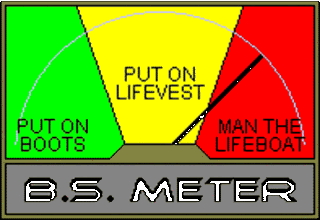 As you might have already heard, last week the EPA announced it was rejecting Texas' proposed rapid-response,140-year plan for restoring air quality and visibility in National Parks affected by pollution from the state's largest industrial facilities, primarily coal-fired power plants, aka, "the haze rule."
As you might have already heard, last week the EPA announced it was rejecting Texas' proposed rapid-response,140-year plan for restoring air quality and visibility in National Parks affected by pollution from the state's largest industrial facilities, primarily coal-fired power plants, aka, "the haze rule."
Instead, the EPA decided to implement its own, slightly more decisive plan for action. Whereas the state concluded it needed no new controls on any coal plants, the EPA is requiring modern Sulfur Dioxide (SOx) scrubbers on 14 different boilers at nine power plant sites across the state it estimates will remove 230,000 tons of the pollutant annually. That's 60% of the state's total SOX pollution, and 7% of the nation's.
These scrubbers not only capture SOx on behalf of more beautiful vistas in Big Bend, they also do a good job of preventing lots of Particulate Matter pollution from reaching the lungs of people that live in between the coal plants and parks. Although computer modeling was used by EPA to determine the effectiveness of the scrubbers it's requiring, it focused on results inside the parks. Getting results for metro areas like DFW involves a lot of data mining nobody has done, but there's no question that if reductions in air pollution are helping Oklahoma and West Texas parks, they're also helping out the air in North Texas. Just one look at the modeling maps produced by our recent UNT study of DFW ozone shows the immense impacts of these plants on DFW air quality.
For residents of DFW, the reductions in pollution are overdue and welcome news (the process leading up to this rule can be traced all the way back to 1977), and it certainly makes it even less likely that the big bad old TXU plants (Big Brown, Monticello and Martin Lake) can escape their obsolescence after bankruptcy proceedings.
But the way the EPA determined to go it alone in this case may be much more important to DFW's own air quality in the long run as the actual reductions it implements.
Not to put too fine a point on it, but EPA called BS on the way Texas was obscuring the data needed to write a good haze rule plan. This M.O. sounds awfully familiar to citizens watching the way the State has drafted its anti-smog plan for DFW, now officially approved by the TCEQ Commissioners and on its way to a public hearing in Arlington on Thursday, January 21st (6 pm, HQ of North Central Texas Council of Governments, 616 Six Flags Road).
And if EPA is willing to stand-up to Texas over air quality in parks, shouldn't it take at least as strong a stand on behalf of seven million souls in DFW?
About the same time EPA was announcing a federal takeover of the haze rule plan, Downwinders released its new video appealing for help from the EPA to reject the State's do-nothing smog plan for DFW. A big part of our case is its reliance on faulty analysis and downplaying or obscuring evidence that contradicts the state's ideological position that no new pollution controls for smog are needed in a region in its third decade of continual violation of the Clean Air Act and after a summer where smog averages increased…twice.
Which makes the language EPA uses to justify this takeover of the haze rule plan all the more relevant, and gives residents some hope should the Agency apply the same logic to the State's pathetic response to DFW's chronic smog problem.
EPA accuses Texas of hiding the most effective control strategies from EPA and Oklahoma (where the Wichita Mountains Wildlife Refuge is affected by Texas-based pollution seven times as much as Oklahoma-based SOx) by flooding its emissions inventory data with both large and small sources of SOx from across the state, washing out the impact of the larger coal plants.
"During the interstate consultation required by the Regional Haze Rule, Oklahoma and Texas discussed the significant contribution of sources in Texas to visibility impairment at the Wichita Mountains, but Texas concluded that no additional controls were warranted for its sources during the first planning period to ensure reasonable progress at the Wichita Mountains, or at its own Class I areas, the Big Bend and the Guadalupe Mountains National Parks.
In reaching this conclusion, Texas relied on an analysis that obscured the benefits of potentially cost-effective controls on those sources or groups of sources with the largest visibility impacts in these Class I areas by inclusion of those controls with little visibility benefit, but which served to increase the total cost figures.
This flawed analysis deprived Oklahoma of the information it needed to properly assess the reasonableness of controls on Texas sources during the consultation process and prevented Texas from properly assessing the reasonableness of controls to remedy visibility at Big Bend and the Guadalupe Mountains.
A few pages later EPA reiterates the charge,
Texas’ analysis was deficient and not approvable because the large control set it selected was not appropriately refined, targeted, or focused on those sources having the most significant and potentially cost-effective visibility benefits. We conclude this control set included controls on sources that would increase total cost figures, but would achieve very little visibility benefit…because Texas only estimated the visibility benefit of all the controls together, it was not able to assess the potential benefit of controlling those sources with the greatest visibility impacts, and potentially cost-effective controls. Therefore, the effects of those controls with the greatest visibility benefits were obscured by the inclusion of those controls with little visibility benefit. This only served to increase the total cost figure, making Texas’ potential control set seem less attractive.
In analyzing whether additional controls should be required for some of its sources under the long-term strategy provisions of the Regional Haze Rule, Texas relied on the same flawed analysis discussed above that it relied on to evaluate additional controls under the reasonable progress provisions to address visibility impairment at Texas’ own Class I areas. Texas’ analytical approach obscured the contributions of individual sources that Texas’ own analysis indicated could be cost-effectively controlled.
This deprived Oklahoma of the information it needed to properly assess whether there were reasonable controls for Texas sources and to properly establish reasonable progress goals for the Wichita Mountains that included the resulting emission reductions.
That's just about as plain an outline of a state government conspiracy to avoid complying with the Clean Air Act as the EPA puts in print. And it sets the stage to examine the State's DFW air plan using the same fine-toothed comb for rooting-out analytical crap meant to obscure inconvenient facts on the ground.
For example, the State's conclusion that no new controls for smog are warranted is based on an analysis of what's "reasonably available" that's every bit as flawed as anything dreamed up by Austin for dodging its responsibilities to national parks. It ignores modern controls already operating on cement kilns, gas compressors, and coal plants – to the point of not even mentioning the permitting of these controls by the TCEQ itself.
Moreover, hard as it is to believe, the state's conclusion on smog controls is based on no modeling of the impact of those controls on air quality. That was left up to Downwinders and its UNT study, using the state's own computer modeling. What that effort provided was nothing less than a road map for how to get the most cost-effective cuts in smog by reducing pollution from those kilns, coal plants, and compressors. This is information the state could have gotten if it wanted it, but it didn't want it because it disputed the ideological position that no new pollution controls for industry are justified. It knew if it looked, it would have to release the results. So it just didn't look.
Finally, the state is still claiming that its plan will get DFW "close enough," to the 75 ppb standard, clocking-in at 77.8 ppb. So the plan doesn't even accomplish its goal. That makes it completely indistinguishable from the last five state air plans for DFW. What the State is counting on is EPA giving them credit for a wish list collection of unquantifiable stuff under the regulatory category of "Weight of Evidence." This is exactly the same strategy used in past plans. Ride new changes in federal law as far as you can and convince the EPA that "trends" are in your favor to make up any slack.
Only this time, "trends" may be working against the State. The summer of 2015 saw an increase in regional smog averages, indicating that perhaps its do-nothing approach isn't working. If you combine this information with the fact that smog levels also rose during the last do-noting plan from 2011, you have some "trends" crying out for an EPA takeover.
Since the TCEQ has approved its DFW air plan for submittal to EPA, we won't have to wait long to find out what the Agency's response will be. Public comments are due by January 29th. Let's hope EPA's review of an air plan for people's health in the nation's fourth largest metropolitan area is as rigorous as it was for the one looking out for visitors to the Wichita Mountains.
“Help Us. We Live in Texas.”
(Dallas)— “Help Us: We Live in Texas.”
That’s the plea of a video released today by a local clean air group claiming the state has so intentionally sabotaged Dallas-Fort Worth anti-smog efforts that residents now need EPA to take over the job.
“Texas is as likely to enforce the Clean Air Act in 2015 as Mississippi was to enforce the Voting Rights Act in 1965,” said Downwinders at Risk’s Director Jim Schermbeck, echoing a line in the video.
The group posted the 2:42 minute piece, titled “SOS @EPA” in response to this morning's vote by the Texas Commission on Environmental Quality (TCEQ) to move forward with a new anti-smog plan for DFW that the Commission has already been told by EPA falls short of legal and regulatory requirements.
In the video, footage from a Downwinders’ street action calling for help at EPA Regional Headquarters in downtown Dallas November 5th is spliced with facts about DFW’s 20 years and counting chronic smog problem. Central to the group’s charge is the state’s unwillingness to put new controls on major sources of industrial air pollution like the Midlothian cement kilns, East Texas coal plants, and gas facilities – despite the fact their own air modeling shows those controls could bring smog down enough to comply with the Clean Air Act.
Today’s vote by the TCEQ is the second in 12 months concerning the same DFW air plan. Its goal is to get from an average of 83 parts per billion (ppb) of smog in 2015 down to the current federal standard of 75 ppb by 2017.
However, the state only estimates a best-case result of almost 78 ppb. Despite that shortfall, there are no new pollution controls required of any major sources. Over the last 20 years, the state has written five anti-smog plans for DFW. None has accomplished its goal on deadline, and regional smog levels actually rose this year.
Besides once again failing to hit is mark overall, the EPA has already told the State its formal assessment of modern pollution controls for those major sources needed revisiting to be legal. TCEQ refused to comply with EPA and today’s plan contains exactly the same assessment as the one EPA has already said isn’t sufficient, making that part of the plan instantly illegal. Although EPA gives state governments authorization to write smog plans for their own metropolitan areas, it still has final approval based on criteria listed in the Clean Air Act.
One of the points made in the group’s video is that studies by local hospitals have shown DFW childhood asthma rates to be as much as four times the state average and over twice the national average, making the need for cleaner air imperative.
“The health of seven million Dallas-Fort Worth residents is being held hostage by a state government hostile to the goal of clean air. Only federal intervention can save us,” said Schermbeck.
The video can be found at Downwinders at Risk’s website (downwindersatrisk.org), it’s Facebook page, twitter account (@cleaner air) and the group’s YouTube channel (Downwinders’ TV).
__________________________________
SEND EPA ADMINISTRATORS A MESSAGE TO REJECT THE STATE'S PLAN AND WRITE ONE OF ITS OWN:
https://www.downwindersatrisk.org/featured-citizen-action/
AND
SIGN THE CHANGE.ORG PETITION:
https://www.change.org/p/ron-curry-and-gina-mccarthy-environmental-protection-agency-reject-texas-smog-plan-for-dallas-ft-worth
________________________________________
LIKE THIS VIDEO? LIKE OUR WORK? THINK IT'S IMPORTANT?
THEN PLEASE MAKE A TAX-DEDUCTABLE CONTRIBUTION TO DOWNWINDERS BEFORE DECEMBER 31st.
DONATE HERE.
________________________________________
WHY?
It might be hard to believe, but despite being the nation’s fourth largest metropolitan area, AND being in constant violation of the Clean Air Act for smog since 1991, AND having higher annual smog numbers than Houston, AND being singled out by EPA as one of only a handful of areas expecting to STILL be in violation of the Clean Air Act in 2025, there’s still only one professional staff person devoted to cleaning up DFW air: the staff person you pay for when you contribute to Downwinders at Risk.
Besides community organizing on the ground, Downwinders also had to go out and build a new committee of local officials concerned about dirty air after the traditional regional air quality planning process broke down. That committee produced a first-ever study showing how new pollution controls on the kilns, coal plants, and compressors could bring smog levels down enough to comply with the Clean Air Act. Our study was used by the Dallas Commissioners Court to pass a resolution requesting new controls on the East Texas coal plants in October. Had it not been for our new committee, there would have been no local officials involved in the DFW air quality planning process at all, and noaccountability for a state government that isn’t interested in our lungs.
Want to get just basic information about DFW air pollution? There are no dedicated environmental beat reporters left in DFW. Downwinders fills this gap as well, providing the only source of reliable and timely information on DFW air quality issues.
Need technical or organizing training? We do that too. Many of you know we just sponsored our first conference – the four-day Root and Branch Revue, featuring a graduating class of 70 grassroots activists from our first “University of Change.”
When you give to Downwinders, you fund the last line of defense between your lungs and a state government that doesn’t believe smog is that bad for you.
And when you give to Downwinders, you know you’re giving to a group with a two decade proven track record of getting results.
That’s our pitch. We get your donation. You get our best effort at protecting your lungs.
On behalf of myself, and the Downwinders at Risk board, thank you for your consideration.

Jim Schermbeck
Director, Downwinders at Risk
State Re-Submits Illegal DFW Smog Plan, Dares EPA to Reject It

(Dallas)– In an unprecedented rebuke to the Environmental Protection Agency, Texas has refused to provide critical data EPA says it needs to approve the state’s controversial anti-smog plan for DFW, which requires no new pollution controls despite more than two decades of chronic bad air.
Texas' refusal to cooperate with EPA puts its plan, scheduled to be approved by the Texas Commission on Environmental Quality December 9th, on a collision course with the federal agency.
Although EPA gives state governments authorization to write smog plans for their own metropolitan areas, it still has final approval based on criteria listed in the Clean Air Act. EPA disapproval of the State's DFW plan would trigger the possibility of a federal takeover of the air planning process.
That would be fine with local air quality activists, who've been pushing for the EPA to take over the job of writing a new clean air plan for North Texas since the State unveiled its first draft last year. They say TCEQ's official position that smog isn't harming public health means the Commission can't be trusted to write an effective anti-smog plan. When the state announced a plan imposing no new controls on any sources of air pollution despite DFW being in continual violation of the Clean Air Act for the last quarter century, they feel they were proven right.
"It's as if the state is too embarrassed to do what EPA is asking for fear of finding facts that don't match its ideology," said Jim Schermbeck, Director of the local clean air group, Downwinders at Risk.
He noted among the most important missing items in the State’s final plan published November 20th was a "Reasonably Available Control Technology"(RACT) study for the Midlothian cement plants, as well as answers to the impact of controls on other sources like the East Texas coal plants and oil and gas facilities that EPA posed in its eleven pages of official comments on the first draft last February. Application of modern pollution controls to all major sources of air pollution in a smog-plagued region is a key component of the Clean Air Act.
In official comments last February, EPA specifically requested the state perform a new study of what kind of smog controls should be required of the three Midlothian cement plants immediately south of DFW. EPA warned lack of such a study would mean the plan would be disapproved:
"Failure to conduct a thorough RACT analysis for cement kilns which would include appropriate emission limits would prevent us from approving the RACT portion of the attainment plan submittal.”
By turning-in the same version of the technology review originally criticized by EPA, without any new additional analysis, the TCEQ began a bureaucratic game of "Chicken," daring the EPA to deny approval.
"If you're EPA, I don't see how you take this any other way than a big raised middle finger from Austin," said Schermbeck. "The question is: What's EPA gonna do about it now?"
Also missing in the final state version are any responses to other EPA's concerns and questions about the plan's chances of actually lowering smog levels and the possibilities of reducing smog with new controls on other sources, such as,
“How would a reduction in NOx emissions from utility electric generators in the counties closest to the eastern and southern boundaries of the DFW area impact the DFW area?”
EPA was already openly skeptical about the chances of the state’s plan succeeding without requiring any additional cuts in pollution. Stating “it would be difficult to see” how the plan meets its required 2017 deadline, the Agency concluded “we believe it is likely that additional reductions will need to be included to demonstrate attainment.”
TCEQ’s resubmitted plan doesn’t have any additional reductions. Failure of a state plan to show how it can reach the smog standard by 2017 would be cause for EPA to assume the job itself.
Evidence suggests the state is purposely overlooking the air quality benefits of controls on large industrial sources of air pollution affecting DFW.
In late October, Downwinders at Risk released a new study of its own. It paid for University of North Texas engineers to build a clone of the State’s DFW air computer model and run a series of control scenarios the state hasn’t performed in almost a decade. Using the TCEQ’s own numbers it showed new controls on the cement kilns, coal plants, and gas compressors in the Barnett Shale would lower smog levels enough to meet the current federal smog standard. DFW hasn’t met a federal standard for smog since once was created in 1991.
Dismissing the results as “limited,” TCEQ officials nevertheless agreed with them – since they were based on their own model. The State argues those new controls are not yet technically or economically feasible – despite their being commonplace around the world, in the US, and even in Texas.
This question is one of the keys to the standoff with EPA: are the proposed new controls for industry “Reasonably Available” or not? If they are, they must be included in the air plan. If not, they remain off the table. EPA makes the first call on a definition, and any aggrieved party can sue to expand or contract it.
Because it’s a national hot spot for smog, DFW is only one of a handful of US metro areas that even had to submit a clean air plan this last cycle. EPA computer modeling predicts the area will still be in violation of the Clean Air Act in 2015 unless significant reductions in pollution are made.
This summer saw the North Texas regional smog average rise twice in one hot August week, retreating from gains made during last year’s cooler, wetter summer. DFW once again has higher annual smog levels than Houston. Both cities remain well above the current standard.
According to the American Lung Association, the 10 county DFW “non-attainment” area for smog includes approximately 150,000 asthmatic children, 350,000 adults with asthma, and over 600,000 adults with cardiovascular disease or COPD – all of whom are at risk from the region’s bad air.
“The lungs and lives of seven million residents are being held hostage by a state government that doesn’t think smog is a problem and isn’t willing to require new pollution controls to reduce it, “ Schermbeck pleaded
“Expecting the State of Texas to enforce Environmental laws in 2015 is like expecting the State of Mississippi to enforce Civil Rights laws in 1965. Our only hope is federal intervention.”
DFW One of Only Ten Areas Nationwide Not Expected to Meet New Smog Standard by 2025
 There was a lot of coverage of last week's announcment of a new, more protective national smog standard by EPA. Most of it centered on the reaction by both sides that it was either not enough progress (public health advocates), or Western Civilization was about to collapse under the weight of all the controls necessary to meet the standard (National Chamber of Commerce, et al.).
There was a lot of coverage of last week's announcment of a new, more protective national smog standard by EPA. Most of it centered on the reaction by both sides that it was either not enough progress (public health advocates), or Western Civilization was about to collapse under the weight of all the controls necessary to meet the standard (National Chamber of Commerce, et al.).
But if you read deeper into the articles, many of them mentioned computer modeling EPA had already done that demonstrated, given current trends, only 14 counties, representing 10 separate areas, wouldn't be able to meet the new standard by the target year of 2025. Unfortutantely, none of those articles mentioned which 14 counties, or which 10 areas.
Now, given all that you already know about our state and regional track record for meeting clean air deadlines, your first question might be: how many of those are in Texas? We'll give you a minute or two to start a pool and pick a number….
And the answer is: Three. Brazoria and Harris Counties in the Houston "non-attainment area" for smog, and Tarrant in DFW's non-attainment area. (The ten areas are: Baltimore, Dallas-Fort Worth, Denver, Fort Collins, Houston, Louisville, Milwaukee, New Haven, New York, and Pittsburgh).
Of course, for the purposes of regional smog record-keeping, EPA doesn't separate Tarrant County numbers from Dallas County, or Denton County, or any of the other nine counties in the non-attainment area. If one monitor is out of compliance in the area, the whole region is considered in violation. So EPA is conceeding that both DFW and Houston will still continue to be in continual violation of the Clean Air Act for another decade.
This is discouraging but not surprising. The State refuses to put new-generation controls on large major polluters like the Midlothian cement plants, East Texas coal plants, and gas production facilities, while painting the rosiest scenarios with its own modeling.
But this new revelation means it's that much more important to get EPA to override the state and act now to include controls on those major polluters, while the current smog plan is in the pipeline. It may be the only chance we have in the next 5-10 years to adequately address these sources. This can only be done if the EPA decides to revoke Texas' authority to write and implement these plans – to commit to a Federal Implementation Plan of its own.
PLEASE….
1) Sign our Change.Org petition urging the EPA to reject the state's clean air plan for DFW and substitute one of its own, and
2) Send an e-mail to the Chief EPA administrator in Washington and the Regional Administrator here in Dallas saying you want them to take responsibility for a new DFW air plan.
Thanks.

